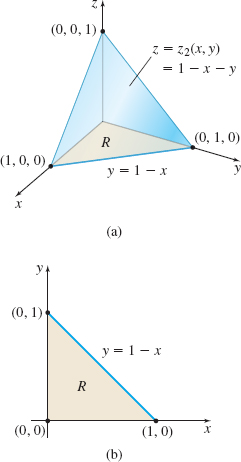EXAMPLE 4Finding the Mass and Center of Mass of a Solid
- (a)
 Find the mass M of a solid in the shape of a tetrahedron cut from the first octant by the plane x+y+z=1 if the mass density ρ=ρ(x,y,z) is proportional to the distance from the yz-plane.
Find the mass M of a solid in the shape of a tetrahedron cut from the first octant by the plane x+y+z=1 if the mass density ρ=ρ(x,y,z) is proportional to the distance from the yz-plane. - (b) Find the center of mass (ˉx,ˉy,ˉz) of the tetrahedron.
Solution Figure 46(a) shows the solid E that is xy-simple. It is enclosed by the surfaces z=z1(x,y)=0 and z=z2(x,y)=1−x−y, and its projection onto the xy-plane is the closed, bounded x-simple region R defined by the lines y=0 and y=1−x, where 0≤x≤1. See Figure 46(b).
(a) Since the mass density ρ=ρ(x,y,z) is proportional to the distance from the yz-plane, we have ρ(x,y,z)=kx, where k is the constant of proportionality. Then the mass M is M=∭
Using a CAS, M=\dfrac{k}{24}.
(b) The center of mass (\bar{x}, \bar{y}, \bar{z}) is \begin{eqnarray*} \bar{x}&=&\dfrac{\iiint\limits_{\kern-2ptE}x\rho ( x, y,z) \,{\it dV}}{M}=\dfrac{ \iiint\limits_{\kern-2ptE}xkx\,{\it dV}}{\dfrac{k}{24}}=24\iiint\limits_{\kern-2ptE}x^{2}\,{\it dV}\\[7pt] &=&24\int_{0}^{1}\int_{0}^{1-x}\int_{0}^{1-x-y}x^{2}\,{\it dz}\,{\it dy}\,{\it dx} \end{eqnarray*}
Using a CAS, \overline{x}=\dfrac{2}{5}. \begin{equation*} \bar{y}=\dfrac{\iiint\limits_{\kern-2ptE}y\rho (x, y,z) \,{\it dV}}{M}=\dfrac{ \iiint\limits_{\kern-2ptE}ykx\,{\it dV}}{\dfrac{k}{24}}=24\int_{0}^{1}\int_{0}^{1-x} \int_{0}^{1-x-y}{\it xy}\,{\it dz}\,{\it dy}\,{\it dx} \end{equation*}
Using a CAS, \bar{y}= \dfrac{1}{5}.
946
\begin{equation*} \bar{z}=\dfrac{\iiint\limits_{\kern-2ptE}z\rho (x, y,z) \,{\it dV}}{M}=\dfrac{ \iiint\limits_{\kern-2ptE}zkx\,{\it dV}}{\dfrac{k}{24}}=24\int_{0}^{1}\int_{0}^{1-x} \int_{0}^{1-x-y}xz\,{\it dz}\,{\it dy}\,{\it dx} \end{equation*}
Using a CAS \ \bar{z}= \dfrac{1}{5}.
The center of mass of the tetrahedron is located at the point \left( \dfrac{2}{5},\dfrac{1}{5},\dfrac{1}{5}\right).
